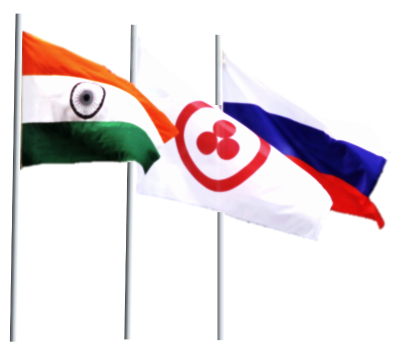03.05.2025
Exhibition of paintings by Lola Lonli "Himachal. Crossroads of Culture" at the Roerich Estate
On May 3, 2025, as part of the festival dedicated to the 90th anniversary of the Roerich Pact and the Banner of Peace, the grand opening of the exhibition of paintings by Lola Lonli, a Russian artist, traveler, and researcher of the cultures of the peoples of the world, took place in the Exhibition Hall of the International Roerich Memorial Trust (India, Kullu, Naggar). Having studied the rich culture of the peoples of the Himalayan valleys for many years, this time the author focuses on its intersections with Slavic and Russian culture. "India is not a foreign land, but a sister of Russia", - wrote Nicholas Roerich, who studied the deep kinship of the cultures of Russia and India. It was in the Himalayan valleys that many things reminded him of his homeland - melodies of songs, folk festivals, wood carvings, patterns on clothes. While working on sketches for N.A. Rimsky-Korsakov's opera "Snegurochka" (Snow Maiden), N.K. Roerich noted the closeness of the images of the Russian Lel and the Indian Krishna.
Continuing and developing these ideas, Lola Lonli presented the characters of N.A.Rimsky-Korsakov's opera "Snegurochka" as inhabitants of the Himalayan valleys of Kullu, Kinnaur and Spiti, against the backdrop of scenery that combines elements of the local landscape and architecture and the symbolism of deities.
The Snow Maiden appears before us in a festive outfit of the inhabitants of the Kinnaur valley, who are famous for their skill in handling metals, so she is adorned with many necklaces. And her headdress resembles the Mordovian or Mari ones. The scenery is the majestic mountains covered with forests and snow surrounding the Kinnaur valley.
Lel is, of course, Krishna, playing the flute and filling all the space around him with love in the form of beautiful flowers, which penetrate into other paintings of the series. He is dressed as a resident of the Kullu Valley, and the pattern of his clothes is both Indian and Slavic.
The artist combines the image of Kupava with the image of Parvati, and her outfit comes from the valleys of the Beas and Parvati rivers. The carved platband depicts the nagas from Kullu and Kinnaur. Kupava is sad because Mizgir now wants to marry not her, but the Snow Maiden...
Mizgir is depicted in a rich Kinnaur outfit, against the background of tridents - attributes of Shiva, and birds, which are a universal symbol of luck, wealth and prosperity.
The father of the Snow Maiden, Grandfather Frost, here becomes Rudra - Frost, kind at heart, but quick to punish. He looks like a gray-haired Shaivite sadhu, and the fir-trees - tridents around him, under certain lighting, "are covered with ice."
Mother Spring is dressed in the Spiti Valley outfit and appears against the backdrop of the golden mountains surrounding the valley. Her translucent mantle is a reference to the sketch by N.K.Roerich. Covering everything around with flowers, she looks sad, because she knows the fate of her daughter: to melt...
The mighty King Berendey is dressed as the ruler of Kinnaur. Shiva's attributes - a trident, a bow with arrows, a fairytale tiger - emphasize his majesty.
Snow Maiden’s adoptive parents - Bobyl and Bobylikha (mean Childless) - are depicted as residents of Kaza, the capital of Spiti. And only the “treukh” hat (“three ears”, hats like that used to be worn in Russia) reveals the Russian soul in Bobyl. The decoration for him is a stylized local traditional house with mountains reflected in the windows.
The paintings were created in a new technique reminiscent of fresco painting, in which the drawing goes from dark to light colors, but made using modern materials. To achieve the effect of volume, combinations of different in density and transparency colors are used.
The exhibition also featured other new works by the artist, including those inspired by visiting local folk festivals. The attention of the exhibition visitors is invariably attracted by the triptych dedicated to the festival of the goddess Durga and representing her three forms - Durga herself, Parvati and Kali in the outfits of the Kullu Valley, surrounded by appropriate attributes. And the diptych "Himachal Cham", created in an expressive manner, transfers the viewer into the round dance of this Buddhist holiday, under the patronage of Guru Rinpoche.
The "Underwater World" series reflects the author's long-standing passion for diving into the depths of the Red Sea, as well as the amazing similarity of peculiar sea creatures with the letters of the Brahmi and Devanagari alphabets. The images of the small portrait series "States of the Soul" express certain moments of the spiritual concentration of the person.
Indian Curator of the IRMT Suresh Kumar highly appreciated the work of Lola Lonli in studying the culture of the peoples of the Himalayas. According to him, working in many museums of Himachal Pradesh - in Chamba, Dharamsala, Shimla, he has not seen such a deep and thorough study of ethnographic material in modern painting. He called Lola Lonli's original style of painting unique, noting its expressiveness and beauty.
Russian Curator of the IRMT Larisa Surgina, working in the Trust under the direction of the International Center of the Roerichs (Moscow), drew attention to the fact that the new works of Lola Lonli, in addition to beauty, also have a tangible energy, reflecting the author's deep penetration into the spiritual life of the peoples of the Himalayas.
Mr. Narender Bali, the Guest of honor who attended the opening, noted that Lola Lonli’s paintings continue the work of the Roerich family in studying the cultures of India and Russia, their commonality and mutual influence, and the development of friendship between our peoples.


















































